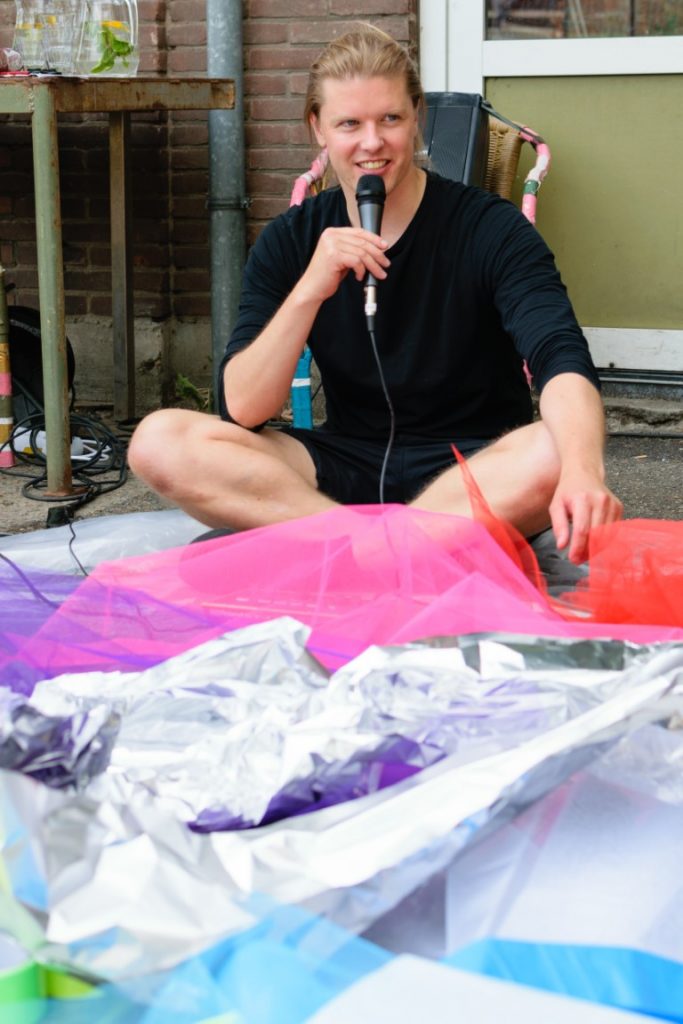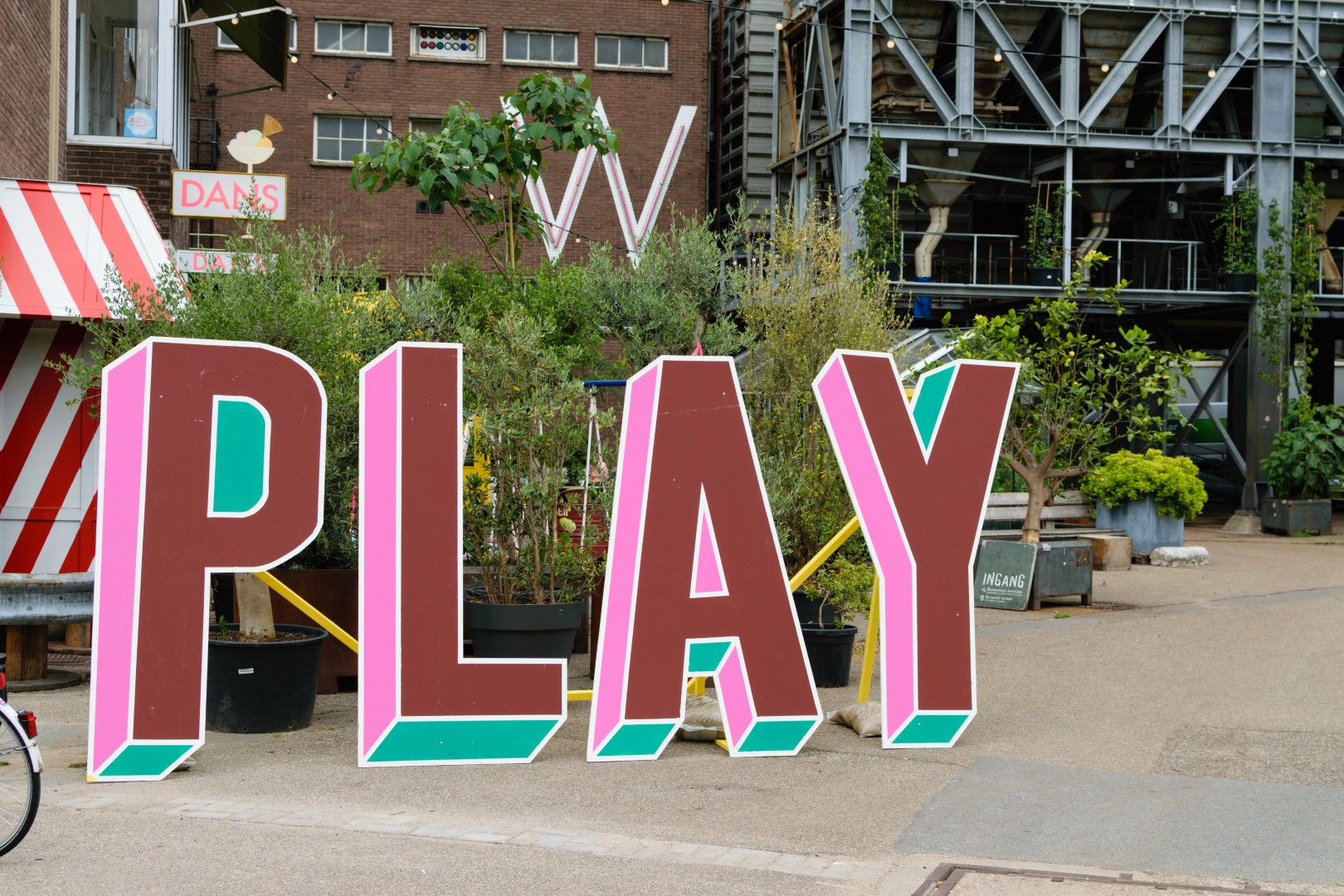[et_pb_section bb_built=”1″][et_pb_row][et_pb_column type=”4_4″][et_pb_text _builder_version=”3.1.1″]
When I was recently driving back from Playful Arts Festival in Den Bosch, the Netherlands, even the dreadful traffic on the Autobahn was not nearly enough to kill my enthusiasm for this great event!
While I haven’t been at Playful Arts before (big mistake!), I’ve been friends with one of the organizers, Zuraida Buter, for several years and we’ve talked a lot about our shared curse and blessing of running play events. I don’t think it’s unfair to say that we’re both somewhat stubborn (maybe “perseverant” is a nicer word? Anyway, you know what I mean) in our efforts to explore the role of playfulness in games, art and our lives. We share the fundamental belief that it’s important to have these events in the world, and that there should be (more, always more!) regular opportunities for the play community to congregate. Otherwise, why keep doing this work? It’s mighty challenging, frustrating (to the point of screaming into the void) at times, and it certainly doesn’t make us rich (but oh, it’s so immensely rewarding in so many other ways and I wouldn’t ever want to live without it).
It goes without saying, then, that I was curious to join their community, learn more about their approach to play and not least their position right on the intersection of play and art. This is a connection I’m deeply intrigued by, but also one I feel a desire to explore in much more depth.
[/et_pb_text][et_pb_image _builder_version=”3.1.1″ src=”http://www.counterplay.org/wp-content/uploads/2018/06/PlayfulArts2018-8254-Large.jpg” /][et_pb_text _builder_version=”3.1.1″]
More than anything, Playful Arts Festival was an important reminder that, for all of us interested in understanding play better, art should be one of the first places we look. Art and play share the fundamental trait that they must both be allowed to exist for no other reason than the experience, with no expectation of any specific outcome (and they both suffer from the contemporary desire to focus solely on results and measurable outcomes – what I have called “ROI Society”). It seems to me that becoming an artist is often also a matter of embracing your playfulness, carving out a space for it to thrive in your work and life. Deep down, I believe we all have this urge to stay playful, and art might be a strategy for maintaining the link to that dimension. Most artists, like other playful people, are always curious, asking questions, exploring the world, turning it upside down, insisting that everything could be different. Or as the (Dutch, as it happens) artist M. C. Escher, famous for his impossibly endless stairs, phrased it:
‘I can’t keep from fooling around with our irrefutable certainties. It is, for example, a pleasure knowingly to mix up two- and three-dimensionalities, flat and spatial, and to make fun of gravity.’
While I’m certainly no artist, I also “can’t keep from fooling around with our irrefutable certainties”. In fact, few things cause more frustration than “the politics of necessity” and the widespread beliefs that there’s an almost destiny-like reason for things being the way they are. Play – and art – reminds us that it’s a big, fat lie, but only if we dare to embrace it, and for that, we need each other. We need our play communities, which often emerges around events like Playful Arts.
So what was this festival all about?
[/et_pb_text][et_pb_text admin_label=”JakobLaCour” _builder_version=”3.1.1″]

On the first day of the festival, arriving on my own, feeling a little overwhelmed, I was eager to get into the proper playful mood. Now, I’m the weird kind of person who absolutely loves play, will go to great lengths to improve the understanding of and conditions for play, yet I’m often intimidated by certain ways of playing. I’m a somewhat picky player, you might say. I’m a little shy by nature, and when play feels more like a performance, I’m usually struggling. It’s a good thing, I guess, since it frequently reminds me that not all forms of play are appealing to all people and diversity and inclusiveness must always be a priority.
I’m still practicing my play skills, and I always try to seek out experiences that are out of my comfort zone. My friend Jakob La Cour, a Danish artist, is usually guaranteed to deliver somewhat intimidating experiences, so I jumped on his contribution – “Random Magic”. He took us on a journey into a mystical dimension, drawing on “the power of the mask”, hiding our faces and trusting the strength of the group. Dressed up, we ventured out into town, communicating only by sounds, running and jumping around before lying on the ground in the middle of a public square. It was a very strange and demanding journey indeed, but one I cherish nonetheless. Jakob manges to truly demonstrate how playing in public can effectively subvert established expectations about the “normal” behavior. Like one participant said:
“I felt sad for all those people looking at us, making such an effort to uphold their serious facades, pretending to be “normal””.
[/et_pb_text][et_pb_text admin_label=”Anthea” _builder_version=”3.1.1″]
It took some time to gather my thoughts and recalibrate my energy levels after this, but it was followed by the official opening with a lovely speech by Zuraida and then another friend, the artist Anthea Moys from Johannesburg, introduced people to her always amazing “Portrait Exchange”. Two and two, people draw portraits of each other – without looking at the paper. Nobody can do this particularly well, so it’s essentially a space for strangers to look intensely at each other, to see each other, and to laugh together. It’s a hilarious activity, but also one that profoundly demonstrates how even the most simple forms of play can bring us a little bit closer together.
[/et_pb_text][et_pb_image _builder_version=”3.1.1″ src=”http://www.counterplay.org/wp-content/uploads/2018/06/PlayfulArts2018-8339-Large.jpg” /][et_pb_text admin_label=”Maaike” _builder_version=”3.1.1″]
The festival was also an occasion for me to meet Maaike de Jong, a philosopher who, among other things, wrote a PhD with the intriguing title “The Paradox of Playfulness” (of which I’ve only read bits and pieces, I’m afraid). At Playful Arts, she attended as “the driving philosopher”, offering “a moment to catch up on impressions, grab ‘a bite to think’ and explore thoughts and ideas in the intersecting fields of playfulness and philosophy”. While I’ve been connected online with Maaike for a while, this was the first time we met in old-fashioned person. I enjoyed our many conversations, and not least her tribute to our mutual friend, the late Bernie DeKoven, titled “Bernie’s Delight”, a short meditation on his idea of the “inner playground”.
[/et_pb_text][et_pb_image admin_label=”Maaike” _builder_version=”3.1.1″ src=”http://www.counterplay.org/wp-content/uploads/2018/06/PlayfulArts2018-8387-Large.jpg” /][et_pb_text admin_label=”Chair_Jump_Chute” _builder_version=”3.1.1″]
Right after this beautiful, touching experience, something rare and surprising happened, as the artwork “Chair_Jump_Chute” by Marloeke van der Vlugt had me dancing around in a public space with people sitting around and I completely forgot about them. I think this was the most pure play experience I had during the festival, as nothing mattered but being inside and prolonging this particular moment. You wear either a kind of scarf or a chair (yes!), and when you move around, you remix music and sounds while interacting with three big installations in the ceilings, shaped like parachutes and dresses. It was magical.
[/et_pb_text][et_pb_image _builder_version=”3.1.1″ src=”http://www.counterplay.org/wp-content/uploads/2018/06/PlayfulArts2018-8389-Large.jpg” /][et_pb_text admin_label=”Bodies in urban space” _builder_version=”3.1.1″]
Next up was the performance “Bodies in Urban Spaces” by Willi Dorner. The team had been picked from applicants coming from Den Bosch, the Netherlands and abroad They only came together for this one performance and had been practicing intensely for a week. It was a kind of parkour, bodies stacked on top of each other in surprising places. I particularly liked that moment when the performers got up from the ground and ran to their next location. The sudden shift, jumping from static posture to a quick dash, produced a compelling energy. The whole thing was just incredible, demonstrating how the playful eye allows you to see the world and a town like Den Bosch from entirely new perspectives.
[/et_pb_text][et_pb_image _builder_version=”3.1.1″ src=”http://www.counterplay.org/wp-content/uploads/2018/06/PlayfulArts2018-8443-Large.jpg” /][et_pb_text admin_label=”Unfolding routines” _builder_version=”3.1.1″]
The last thing I’ll mention is “Unfolding Routines” by “Moha Project”, which ran for a day during the festival, inviting participants on a special tour of a local hotel. Sadly, I missed it, but I attended their somewhat alternative “press conference” the next day. Right from the outset, you knew that something was off with all of this and it culminated when they suddenly presented “the Hungarian corpse”, one of the performers played dead and was dragged around the festival site as a very strange “lit de parade” (even among completely innocent non-festival visitors having dinner). It was weird in a David Lynch kinda way. Brilliant.
[/et_pb_text][et_pb_image _builder_version=”3.1.1″ src=”http://www.counterplay.org/wp-content/uploads/2018/06/PlayfulArts2018-8563-Large.jpg” /][et_pb_image _builder_version=”3.1.1″ src=”http://www.counterplay.org/wp-content/uploads/2018/06/PlayfulArts2018-8564-Large.jpg” /][et_pb_text _builder_version=”3.1.1″]
While the keen eye will immediately spot many obvious similarities between art and play, it nonetheless takes a concentrated effort to demonstrate these links. Too often when hosting play events, I fail to give art and artists the space they deserve, and I think I’m far from alone. Maybe we think we have to reinvent the field of play, building something from scratch, forgetting the long tradition of play in art? This is why a unique initiative like the Playful Arts Festival is so important, since it is one of the only recurring events (that I know of) to insist on seeing art through the lens of play and play through the lens of art – at the same time and with equal respect for both.
During the festival, Zuraida had invited some of us to a meeting (a meeting, yes, but it was very playful indeed), asking how we can create closer ties between the many different play events happening around Europe (and the rest of the world). Part of it is
a matter of helping each other out, reducing the barriers of running events, securing better funding and making logistics less of a hassle. Much more important, however, is our shared capacity to invite more people in, broadening and strengthening the play community across events and borders.
This, as I’ve said many times before, is how we can really have an impact, making our lives and societies more playful and, hence, better suited for actual, playful human beings.
I have no doubt that Playful Arts remains a core pillar of this community, and I look forward to going back!
[/et_pb_text][/et_pb_column][/et_pb_row][/et_pb_section]

Leave a Reply